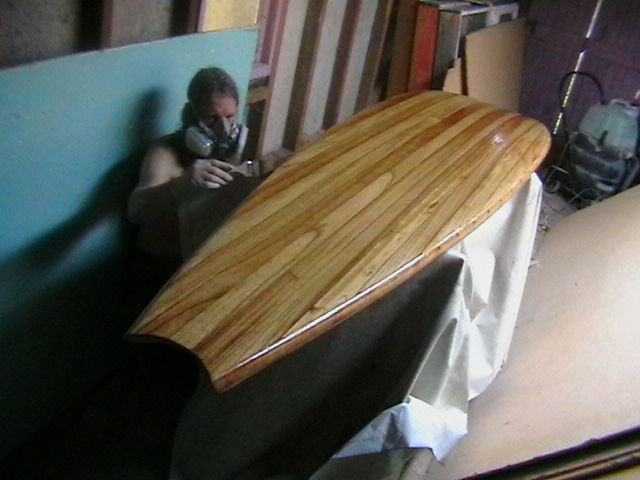Tips for finishing surfboards with resin:
Start with a double brushed coat, that is to say the first coat is applied to the wood liberally, and then as soon as that is done ( provided that it's warm enough and the first coat has started to thicken ) apply another liberal brushed coat straight over the top, and let that one cure overnight (or until it is just sandable but not completely cured because we still want it to bond with the next coats). So at that stage hit it with sharp 40 grit, but gently, until most of the surface is sanded, this is part of the fairing process .If the resin has cured too far for a good chemical bond or there is a blush on it then the 40 grit sanding must eliminate all shiny spots and the whole surface must be sanded. Once that's done ,apply another double coat as before, and if all's well the coats are finished and the board is turned over and the other side is now done before the resin has cured completely, so that the lap around the rails bonds together .
It's important to make the first coat a thick double layer as the coat needs to be thick enough to be sanded without going through to the wood. . .. sanding through to the wood will mean that the wood fuzzes up slightly, this is ok in a few spots but if it happens all over the board then it meands another coat. . . and if THAT coat isn't thick enough the whole problem occurs again . . so best to lay it on thickly at first.
If the coats are a bit too rough and or too thin then a third or fourth application can be done, this doesn't have to add weight as the sanding and fairing process removes the resin except where it is needed in the hollows.
Lapping the coats right around the rails is important as the resin runs off the rails making it harder to get a build up of thickness. lapping the coats right around the rail doubles the number of coats on the rails.
If there are any nicks, dents or pinholes too deep to be faired out these can be filled with the clear epoxy used for a coat once it has become thick and treacly, or gummy even. . . just come back a while after the coat and fill the dents, it doesn't matter if resin blobs stick up a bit as they will just be sanded off later
Remember to use natural bristle brushes only, and also to drill a pilot hole for your vent so that the board doesn't pressurise from the heat of the resin curing and blow pinholes out through the resin.
When we started out we used foam rollers with thin coats and sanded with fine sandpaper between coats, some thin coats on a board would only be about 30 to 50ml, the results were really good but sometimes a dozen or more coats were done. Brushes are way faster and much better than squeegees if cloth isn't being used.
.

